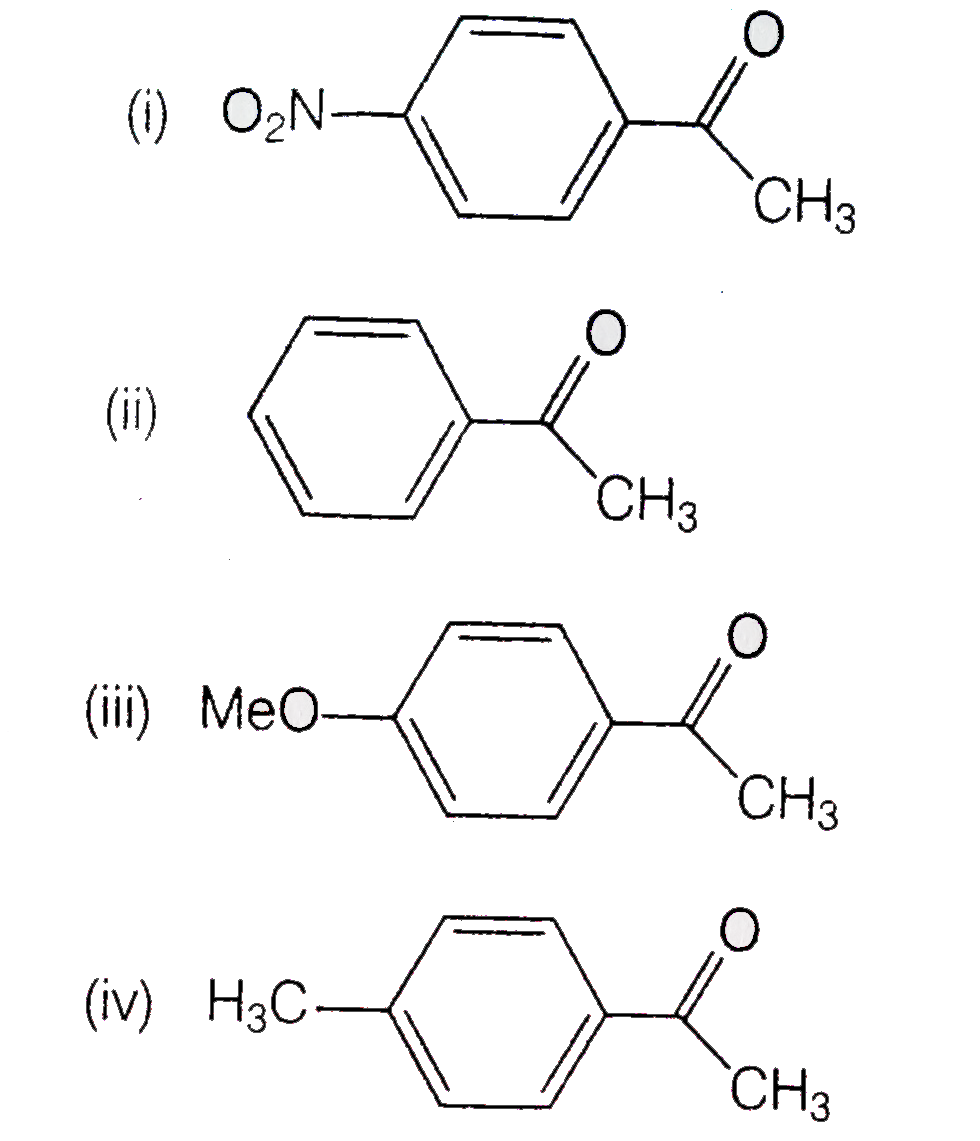Arrange the following in the increasing order of their property indicated
Acetaldehyde, Acetone, Methyl tert butyl ketone (reactivity towards NH2OH)
To arrange Acetaldehyde, Acetone, and Methyl tert-butyl ketone in increasing order of their reactivity towards hydroxylamine (NH2OH), we need to consider the steric hindrance around the carbonyl carbon of each compound.
1. Identify the Structures:
- Acetaldehyde (CH3CHO): It has one methyl group and one hydrogen attached to the carbonyl carbon.
- Acetone (CH3COCH3): It has two methyl groups attached to the carbonyl carbon.
- Methyl tert-butyl ketone (C(CH3)3C=O): It has three methyl groups attached to the carbonyl carbon.
2. Understand the Reactivity:
- The reactivity of carbonyl compounds towards nucleophiles (like NH2OH) is influenced by steric hindrance. The more sterically hindered the carbonyl carbon is, the less reactive it will be towards nucleophilic addition.
- Acetaldehyde has the least steric hindrance because it has one hydrogen and one methyl group.
- Acetone has moderate steric hindrance with two methyl groups.
- Methyl tert-butyl ketone has the highest steric hindrance due to three bulky methyl groups.
3. Rank the Reactivity:
- Since reactivity is inversely proportional to steric hindrance:
- Acetaldehyde (least steric hindrance) will be the most reactive.
- Acetone (moderate steric hindrance) will be next.
- Methyl tert-butyl ketone (most steric hindrance) will be the least reactive.
4. Final Order:
- The increasing order of reactivity towards NH2OH is:
- Methyl tert-butyl ketone < Acetone < Acetaldehyde
Summary:
The final arrangement in increasing order of reactivity towards NH2OH is:
Methyl tert-butyl ketone < Acetone < Acetaldehyde
- Acetaldehyde (CH3CHO): It has one methyl group and one hydrogen attached to the carbonyl carbon.
- Acetone (CH3COCH3): It has two methyl groups attached to the carbonyl carbon.
- Methyl tert-butyl ketone (C(CH3)3C=O): It has three methyl groups attached to the carbonyl carbon.
- The reactivity of carbonyl compounds towards nucleophiles (like NH2OH) is influenced by steric hindrance. The more sterically hindered the carbonyl carbon is, the less reactive it will be towards nucleophilic addition.
- Acetaldehyde has the least steric hindrance because it has one hydrogen and one methyl group.
- Acetone has moderate steric hindrance with two methyl groups.
- Methyl tert-butyl ketone has the highest steric hindrance due to three bulky methyl groups.
- Since reactivity is inversely proportional to steric hindrance:
- Acetaldehyde (least steric hindrance) will be the most reactive.
- Acetone (moderate steric hindrance) will be next.
- Methyl tert-butyl ketone (most steric hindrance) will be the least reactive.
- The increasing order of reactivity towards NH2OH is:
- Methyl tert-butyl ketone < Acetone < Acetaldehyde
The final arrangement in increasing order of reactivity towards NH2OH is:
Methyl tert-butyl ketone < Acetone < Acetaldehyde
Topper's Solved these Questions
- SAMPLE PAPER 2022 TERM IIBOOK - CBSE MODEL PAPERCHAPTER - SAMPLE PAPER 2022 TERM IIEXERCISE - SECTION-B
29 Videos
- SAMPLE PAPER 2022 TERM IIBOOK - CBSE MODEL PAPERCHAPTER - SAMPLE PAPER 2022 TERM IIEXERCISE - SECTION-C
5 Videos
- SAMPLE PAPER 2022BOOK - CBSE MODEL PAPERCHAPTER - SAMPLE PAPER 2022EXERCISE - SECTION C
6 Videos
- SAMPLE PAPER 2023 TERM IBOOK - CBSE MODEL PAPERCHAPTER - SAMPLE PAPER 2023 TERM IEXERCISE - SECTION E
7 Videos
Similar Questions
Give chemical tests to distinguish between
(i) Propanal and propanone
(ii) Benzaldehyde and acetophenone
(b) Arrange the following compounds in an increasing order of their property as indicated :
(i) Acetaldehyde, Acetone , Methyl tert-butyl ketone (reactivity towards HCN)
(ii) Benzoic acid ,3,4-Dinitrobenzoic acid , 4-Metthoxybenzoic acid (acid strength)
(iii) CH3CH2CH(Br)(COOH),CH3CH(Br)CH2COOH,(CH3)2CHCOOH (acid strength)
View SolutionArrange in the following in increasing order of property indicated:
Size I, F, Cl, Br
View Solution
Knowledge Check
Choose the most appropriate options.
Arrange the following compounds in the increasing order of their reactivity towards HCN
I. Acetaldehyde
II. Acetone
III. Di-tert-butyl ketoneAIII>II>IV>IBII>I>IV>IICIV>III>II>IDII>IV>I>IArrange the following in the increasing order of reactivity towards aldol condensation reaction
 A(i)<(ii)<(iii)<(iv)B(iv)<(iii)<(ii)<(i)C(iii)<(ii)<(iv)<(i)D(iii)<(iv)<(ii)<(i)
A(i)<(ii)<(iii)<(iv)B(iv)<(iii)<(ii)<(i)C(iii)<(ii)<(iv)<(i)D(iii)<(iv)<(ii)<(i)Arrange the following compounds in the decreasing order of their reactivity towards SN2 reaction :
 Aiv>iii>i>iiBii>i>iii>ivCi>ii>iv>iiiDiii>ii>i>iv
Aiv>iii>i>iiBii>i>iii>ivCi>ii>iv>iiiDiii>ii>i>iv
Arrange the following compounds in increasing order of their property as indicated :
(i) Acetaldehyde, Acetone, Di - tery - butyl ketone, Methyl tert - butyl ketone (reactivity towards HCN)
CH3CH2CH(Br)CH2COOH,(CH3)2CHCOOH,CH3CH2CH2COOH( acid strength).
(iii) Benzoic acid, 4 - Nitrobenzoic acid, 3, 4 - Dinitrobenzoic acid, 4 - Methoxybenzoic acid (acid strength).
View SolutionArrange the following compounds in the increasing order of their property as indicated:
i. Acetaldehyde, acetone, di-tert-butyl ketone, methyl tert-butyl ketone (reactivity towards HCN).
ii. CH3CH2CH(Br)COOH,CH3CH(Br)CH2COOH,(CH3)2CHCOOH,CH3CH2CH2COOH (acidic strength).
iii. Benzoic acid, 4-nitrobenzoic acid, 3,4-dinitro-benzoic acid, 4-methoxybenzoic acid (acidic strength).
View SolutionArrange the following compounds in the increasing order of their property as indicated:
i. Acetaldehyde, acetone, di-tert-butyl ketone, methyl tert-butyl ketone (reactivity towards HCN).
ii. CH3CH2CH(Br)COOH,CH3CH(Br)CH2COOH,(CH3)2CHCOOH,CH3CH2CH2COOH (acidic strength).
iii. Benzoic acid, 4-nitrobenzoic acid, 3,4-dinitro-benzoic acid, 4-methoxybenzoic acid (acidic strength).
View SolutionArrange the following in increasing order of property indicated:
Oxidising power I, F, Br, Cl
View SolutionArrange in increasing order of the property indicated :
Pb,Pb2+ and Pb4+ (size)
View Solution
